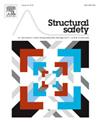Impact of component damage correlations on seismic fragility and risk assessment of multi-component bridge systems
IF 6.3
1区 工程技术
Q1 ENGINEERING, CIVIL
引用次数: 0
Abstract
Seismic fragility modeling of bridges has evolved from simplified system-level assessments to high-fidelity, component-based methodologies. However, a key challenge remains in accurately incorporating damage dependency among bridge components, which might influence high-resolution seismic risk estimates that rely upon damage simulations of each bridge component. While previous studies have explored demand and capacity correlations in various structures, a comprehensive framework integrating these dependencies within the component-based bridge fragility modeling approach remains absent. This study addresses this gap by introducing a refined methodology for modeling seismic damage correlations across bridge components and damage states. A correlation-based fragility modeling framework is proposed, leveraging joint probabilistic seismic demand models and a hierarchical capacity correlation structure. The framework is systematically compared against other correlation models, including fully independent, fully correlated, and partially correlated approaches. Using a four-span, multi-column reinforced concrete bridge as a benchmark, the influence of correlation modeling on key seismic risk metrics, such as bridge collapse fragility, repair costs, and recovery durations, is assessed. Results demonstrate that neglecting damage correlation, or treating it perfectly correlated, sometimes would lead to significant biases in risk estimations. The proposed framework provides a practical extension of the existing component-level seismic fragility modeling approach for seamlessly integrating correlation effects, improving its effectiveness and applicability for downstream risk and resilience assessment of bridge systems.
构件损伤相关性对多构件桥梁体系地震易损性及风险评估的影响
桥梁的地震易损性建模已经从简化的系统级评估发展到高保真的、基于构件的方法。然而,一个关键的挑战仍然是如何准确地结合桥梁构件之间的损伤依赖关系,这可能会影响依赖于每个桥梁构件损伤模拟的高分辨率地震风险估计。虽然以前的研究已经探索了各种结构的需求和容量相关性,但在基于组件的桥梁脆弱性建模方法中集成这些依赖关系的综合框架仍然缺乏。本研究通过引入一种精细的方法来模拟桥梁构件和损伤状态之间的地震损伤相关性,从而解决了这一差距。利用联合概率地震需求模型和分层能力关联结构,提出了一种基于关联的脆弱性建模框架。该框架与其他相关模型进行了系统的比较,包括完全独立、完全相关和部分相关的方法。以一座四跨多柱钢筋混凝土桥梁为基准,评估了相关建模对桥梁倒塌易损性、修复成本和恢复时间等关键地震风险指标的影响。结果表明,忽略损害相关性,或将其视为完全相关,有时会导致风险估计的显著偏差。该框架为现有构件级地震易损性建模方法提供了实用扩展,可无缝集成相关效应,提高了其在桥梁体系下游风险和恢复力评估中的有效性和适用性。
本文章由计算机程序翻译,如有差异,请以英文原文为准。
求助全文
约1分钟内获得全文
求助全文
来源期刊

Structural Safety
工程技术-工程:土木
CiteScore
11.30
自引率
8.60%
发文量
67
审稿时长
53 days
期刊介绍:
Structural Safety is an international journal devoted to integrated risk assessment for a wide range of constructed facilities such as buildings, bridges, earth structures, offshore facilities, dams, lifelines and nuclear structural systems. Its purpose is to foster communication about risk and reliability among technical disciplines involved in design and construction, and to enhance the use of risk management in the constructed environment
 求助内容:
求助内容: 应助结果提醒方式:
应助结果提醒方式:


